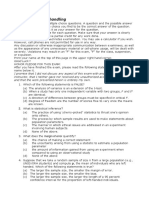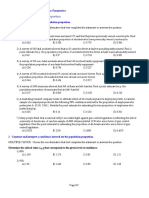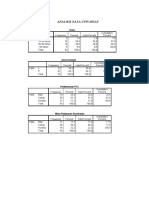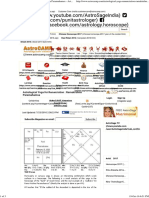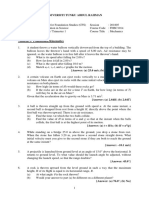Test 8A AP Statistics Name:: Circle The Letter Corresponding To The Best Answer
Test 8A AP Statistics Name:: Circle The Letter Corresponding To The Best Answer
Uploaded by
Sri KannanCopyright:
Available Formats
Test 8A AP Statistics Name:: Circle The Letter Corresponding To The Best Answer
Test 8A AP Statistics Name:: Circle The Letter Corresponding To The Best Answer
Uploaded by
Sri KannanOriginal Title
Copyright
Available Formats
Share this document
Did you find this document useful?
Is this content inappropriate?
Copyright:
Available Formats
Test 8A AP Statistics Name:: Circle The Letter Corresponding To The Best Answer
Test 8A AP Statistics Name:: Circle The Letter Corresponding To The Best Answer
Uploaded by
Sri KannanCopyright:
Available Formats
Test 8A AP Statistics Name:
Part 1: Multiple Choice. Circle the letter corresponding to the best answer.
1. In an opinion poll, 25% of a random sample of 200 people said that they were strongly
opposed to having a state lottery. The standard error of the sample proportion is
approximately
(a) 0.0094
(b) 0.0306
(c) 0.0353
(d) 0.2500
(e) 6.1237
2. A marketing consultant wants to estimate the proportion of all shoppers at a certain mall who
make at least one purchase. He stands at a mall exit for two hours on a weekday afternoon
and flips a coin each time a shopper leaves. If the coin comes up heads, he asks them if they
have made any purchases during this visit. After two hours, he has 132 responses, 104 of
whom made a purchase. Which condition for constructing a confidence interval for a
proportion has the consultant failed to satisfy?
(a) npˆ 10
(b) n 1 pˆ 10
(c) n 30
(d) The data is a random sample from the population of interest.
(e) The sample is less than 10% of the population.
3. The report of a sample survey of 1,014 adults says, "With 95% confidence, between 9% and
15% of all Americans expect to spend more money on gifts this year than last year." What
does the phrase "95% confidence" mean?
(a) 95% of all Americans will spend between 9% and 15% more than what they spent last
year.
(b) 9% to 15% of all Americans will spend 95% of what they spent last year.
(c) there is a 95% chance that the percent who expect to spend more is between 9% and 15%.
(d) the method used to get the interval from 9% to 15%, when used over and over, produces
intervals which include the true population percentage about 95% of the time.
(e) we can be 95% confident that the method used to get the interval always gives the right
answer.
378 The Practice of Statistics, 4/e- Chapter 8 © 2011 BFW Publishers
4. The survey in the previous question was conducted by calling land-line telephones, and those
conducting the survey are concerned about the possibility of undercoverage, since some
people do not own a phone or own only a cell phone. Which of the following is the best way
for them to correct for this source of bias?
(a) Use a lower confidence level, such as 80%.
(b) Use a higher confidence level, such as 99%.
(c) Take a larger sample.
(d) Use a t-interval instead of a z-interval.
(e) Throw this sample out and start over again with a better sampling method.
5. Some scientists believe that a new drug would benefit about half of all people with a certain
blood disorder. To estimate the proportion of patients who would benefit from taking the
drug, the scientists will administer it to a random sample of patients who have the blood
disorder. What sample size is needed so that the 95% confidence interval will have a margin
of error of no more than 3%?
(a) 748
(b) 1068
(c) 1503
(d) 2056
(e) 2401
6. Which of the following has the highest probability?
(a) Randomly selecting a value greater than 3 from a standard Normal distribution.
(b) Randomly selecting a value greater than 3 from a t-distribution with 4 degrees of
freedom.
(c) Randomly selecting a value greater than 3 from a t-distribution with 20 degrees of
freedom.
(d) Randomly selecting a value less than 3 from a standard Normal distribution.
(e) Randomly selecting a value less than 3 from a t-distribution with 20 degrees of freedom.
7. A nationwide poll of 2,525 adults estimated with 95% confidence that the proportion of
Americans who support health care reform is 0.78 0.0162. A member of Congress thinks
that 95% confidence isn't enough. He wants to be 99% confident. How would the margin of
error of a 99% confidence interval based on the same sample compare with the 95% interval?
(a) It would be smaller, because it omits only 1% of the possible samples instead of 5%.
(b) It would be the same, because the sample is the same.
(c) It would be larger, because higher confidence requires a larger margin of error.
(d) Can't tell, because the margin of error varies from sample to sample.
(e) Can't tell, because it depends on the size of the population.
© 2011 BFW Publishers The Practice of Statistics, 4/e- Chapter 8 379
8. You want to calculate a 98% confidence interval for a population mean from a sample of
n = 18. What is the appropriate critical t*?
(a) 2.110
(b) 2.326
(c) 2.539
(d) 2.552
(e) 2.567
9. The heights (in inches) of males in the United States are believed to be approximately Normally
distributed with mean µ. The mean height of a random sample of 25 American adult males is
found to be x 69.72 inches and the standard deviation s = 4.15. What is the standard error of
x?
(a) 0.17
(b) 0.69
(c) 0.83
(d) 1.856
(e) 2.04
10. In checking conditions for constructing confidence intervals for a population mean, it’s
important to plot the distribution of sample data. Below are dot plots describing samples
from three different populations. For which of the three samples would it be safe to construct
a t-interval?
Sample Y Sample Z
n = 41 n = 24
Sample X
n = 13
0 1 2 3 4 5 6 7 8 9
0 1 2 3 4 5 6 7 8 9
0 1 2 3 4 5 6 7 8 9 10 11
(a) Sample X only
(b) Sample Y only
(c) Sample Z only
(d) Samples Y and Z
(c) None of the samples
380 The Practice of Statistics, 4/e- Chapter 8 © 2011 BFW Publishers
Part 2: Free Response
Show all your work. Indicate clearly the methods you use, because you will be graded on the
correctness of your methods as well as on the accuracy and completeness of your results and
explanations.
11. A local newspaper in a large city wants to assess support for the construction of a highway
by-pass around the central business district to reduce downtown traffic. They survey a
random sample of 1152 residents and find that 543 of them support the bypass.
Construct a 95% confidence interval to estimate the proportion of residents who support
construction of the bypass.
© 2011 BFW Publishers The Practice of Statistics, 4/e- Chapter 8 381
12. There are many ways to measure the reading ability of children. Research designed to
improve reading performance is dependent on good measures of the outcome. One
frequently used test is the DRP, or Degree of Reading Power. A researcher suspects that the
mean score µ of all third- graders in Henrico County Schools is different from the national
mean, which is 32. To test her suspicion, she administers the DRP to an SRS of 44 Henrico
County third-grade students. The distribution of scores is summarized in the Minitab output
below:
MEAN STDEV SEMEAN MIN Q1 MEDIAN Q3
MAX
DRP 35.09 11.19 1.69 14.00 26.00 35.00 44.00
54.00
(a) Construct a 90% confidence interval to estimate the mean DRP score in Henrico County
Schools.
(b) Use the confidence interval you constructed in (a) to comment on whether you agree with
the researcher’s claim. Explain your reasoning clearly.
382 The Practice of Statistics, 4/e- Chapter 8 © 2011 BFW Publishers
You might also like
- Stat2507 FinalexamDocument12 pagesStat2507 Finalexamyana22100% (1)
- Multiple Choice Questions Business StatisticsDocument60 pagesMultiple Choice Questions Business StatisticsChinmay Sirasiya (che3kuu)No ratings yet
- MATH 221 Final Exam Statistics For DecisionDocument8 pagesMATH 221 Final Exam Statistics For DecisiongeorgettashipleyNo ratings yet
- Homework Assignment-1Document4 pagesHomework Assignment-1John Depasquale0% (1)
- Stats 8 Practice TestDocument6 pagesStats 8 Practice TestJinWoo (Harvard) PARKNo ratings yet
- Statistics FinalReviewDocument8 pagesStatistics FinalReviewGaneshNo ratings yet
- Statistics FinalReviewDocument8 pagesStatistics FinalReviewWolf's RainNo ratings yet
- Statistics Test PDFDocument8 pagesStatistics Test PDFN.SHANKAR100% (1)
- Ch. 10 ReviewDocument8 pagesCh. 10 ReviewsavannahNo ratings yet
- Ch. 9 Multiple Choice Review Questions: 1.96 B) 1.645 C) 1.699 D) 0.90 E) 1.311Document5 pagesCh. 9 Multiple Choice Review Questions: 1.96 B) 1.645 C) 1.699 D) 0.90 E) 1.311payal khatriNo ratings yet
- Reading 5 Sampling and EstimationDocument29 pagesReading 5 Sampling and EstimationARPIT ARYANo ratings yet
- Ch9_quesDocument9 pagesCh9_quesa0903066594No ratings yet
- 1) TRUE/FALSE. Write T If The Statement Is True and F If The Statement Is FalseDocument11 pages1) TRUE/FALSE. Write T If The Statement Is True and F If The Statement Is FalseAA BB MMNo ratings yet
- Practis Exam Chapter 8Document12 pagesPractis Exam Chapter 8Ngọc YếnNo ratings yet
- Chapter 8 Test ReviewDocument7 pagesChapter 8 Test ReviewKristel ShaneNo ratings yet
- Confidence Intervals: Assignment 3Document4 pagesConfidence Intervals: Assignment 3yoftahe habtamuNo ratings yet
- First Course in Statistics 12th Edition McClave Test Bank DownloadDocument38 pagesFirst Course in Statistics 12th Edition McClave Test Bank DownloadGrace Butcher100% (18)
- STAT 23400 Spring 2023 Homework 7: X, - . -, X N µ, σ σ - x X - µ n µ n σ s - µ n µ n n σDocument2 pagesSTAT 23400 Spring 2023 Homework 7: X, - . -, X N µ, σ σ - x X - µ n µ n σ s - µ n µ n n σqq6kdkftpnNo ratings yet
- Stab22h3 A17Document30 pagesStab22h3 A17fiona.li388No ratings yet
- 19923Document52 pages19923alzabiwoldieNo ratings yet
- Final Exam Fall 2022 - Paper 3 (Quesitons and Answers)Document20 pagesFinal Exam Fall 2022 - Paper 3 (Quesitons and Answers)dungnhse180163No ratings yet
- Assignment #3Document9 pagesAssignment #3Imen Ksouri100% (1)
- Get First Course in Statistics 11th Edition McClave Test Bank free all chaptersDocument52 pagesGet First Course in Statistics 11th Edition McClave Test Bank free all chaptersgjylerezhanNo ratings yet
- Sample of Final Exam PDFDocument5 pagesSample of Final Exam PDFAA BB MMNo ratings yet
- BMTH202 Sample Final PDFDocument5 pagesBMTH202 Sample Final PDFloor chidiac100% (1)
- test_9bDocument4 pagestest_9boctober.dgNo ratings yet
- Confidence Intervals For Proportions and Means Practice PDFDocument2 pagesConfidence Intervals For Proportions and Means Practice PDFAnna AnnaNo ratings yet
- Math 131 Pencastreview3!8!11Document10 pagesMath 131 Pencastreview3!8!11Ahmed El KhateebNo ratings yet
- Exam2 spr20Document6 pagesExam2 spr20Auguste RiedlNo ratings yet
- PDF First Course in Statistics 12th Edition McClave Test Bank downloadDocument64 pagesPDF First Course in Statistics 12th Edition McClave Test Bank downloadyerroukylli100% (5)
- Sst4e Tif 09Document18 pagesSst4e Tif 09Fatima AbubakarNo ratings yet
- Exam Practise QuestionsDocument42 pagesExam Practise Questionsngcamusiphesihle12No ratings yet
- All chapter download Elementary Statistics A Step by Step Approach 8th Edition Bluman Test BankDocument49 pagesAll chapter download Elementary Statistics A Step by Step Approach 8th Edition Bluman Test BankwaikaahiNo ratings yet
- First Course in Statistics 11th Edition McClave Test Bank all chapter instant downloadDocument60 pagesFirst Course in Statistics 11th Edition McClave Test Bank all chapter instant downloadyerroukylli100% (5)
- Final Exam Fall 2019Document12 pagesFinal Exam Fall 2019Shady BoulosNo ratings yet
- HNS B308 Biostatistics Msa CampusDocument7 pagesHNS B308 Biostatistics Msa Campusjamilasaeed777No ratings yet
- Chapter 7Document3 pagesChapter 7Carla Margheritti0% (1)
- Nov2023 - EXAM 2 - MEMO - EfbcDocument37 pagesNov2023 - EXAM 2 - MEMO - EfbcchingayanivelleNo ratings yet
- MTH302 Solved MCQs Mega FileDocument34 pagesMTH302 Solved MCQs Mega Filemuqadasnisar70No ratings yet
- AP Stats Practice ch1Document6 pagesAP Stats Practice ch1Chae ChaeNo ratings yet
- AP Stat - Test 9 (Chapters 19-24) - 2005-2006Document4 pagesAP Stat - Test 9 (Chapters 19-24) - 2005-2006sarvinpsgNo ratings yet
- AP Statistics Name - Chapter 10 Review Part I - Multiple Choice (Questions 1-10) - Circle The Answer of Your ChoiceDocument4 pagesAP Statistics Name - Chapter 10 Review Part I - Multiple Choice (Questions 1-10) - Circle The Answer of Your ChoiceJamesNo ratings yet
- Questions & Answers Chapter - 7 Set 1Document6 pagesQuestions & Answers Chapter - 7 Set 1FaridOrahaNo ratings yet
- Assignment04 Math 215Document14 pagesAssignment04 Math 215Shaily PatelNo ratings yet
- FinalExamMCprepV3students 1Document15 pagesFinalExamMCprepV3students 1Đỗ Thị HuệNo ratings yet
- Set 2 2022 Review QuestionsDocument12 pagesSet 2 2022 Review Questionsmailforjunkstuff22No ratings yet
- University of Toronto Scarborough STAB22 Final Examination: December 2011Document22 pagesUniversity of Toronto Scarborough STAB22 Final Examination: December 2011examkillerNo ratings yet
- Objective QuestionsDocument7 pagesObjective QuestionsAnkur AroraNo ratings yet
- 10 SampleDocument15 pages10 SampleKyle Dean Thomas100% (1)
- Sampling and EstimationDocument7 pagesSampling and Estimationadityaharish18No ratings yet
- Model Paper - Business StatisticsDocument7 pagesModel Paper - Business StatisticsIshini SaparamaduNo ratings yet
- IS106 - FinalExam - B Nescel John PerpasDocument5 pagesIS106 - FinalExam - B Nescel John Perpascelsa empron0% (1)
- AP Statistics Multiple Choice PracticeDocument10 pagesAP Statistics Multiple Choice PracticeDr. DriftNo ratings yet
- Written AssignmentDocument3 pagesWritten AssignmentParul TandonNo ratings yet
- Stats 9 Practice TestDocument5 pagesStats 9 Practice Test조민성No ratings yet
- Chapter 09Document16 pagesChapter 09Muneeb_2kNo ratings yet
- Final. Estimation of Population Parameters Chapter Test Sabordo VillabitoDocument9 pagesFinal. Estimation of Population Parameters Chapter Test Sabordo VillabitoMeanMeanNo ratings yet
- Worksheets for the GSDocument4 pagesWorksheets for the GSJerima PilleNo ratings yet
- The Numerate Leader: How to Pull Game-Changing Insights from Statistical DataFrom EverandThe Numerate Leader: How to Pull Game-Changing Insights from Statistical DataNo ratings yet
- Hydroxyl Value in Polyols (DIN 53240-2:2007-11) : Mettler Toledo Application M091-08Document6 pagesHydroxyl Value in Polyols (DIN 53240-2:2007-11) : Mettler Toledo Application M091-08hanna.costantinNo ratings yet
- Sbcouplings: Product InformationDocument16 pagesSbcouplings: Product InformationAnonymous wCDPbgMLJNo ratings yet
- THCS Phuoc ThanhDocument9 pagesTHCS Phuoc Thanhghan08092009No ratings yet
- Pre-Feasibility Study: Gaming ZoneDocument25 pagesPre-Feasibility Study: Gaming ZoneShehraam MalikNo ratings yet
- Scoring Guide For Teaching Skills Completed Ahead of Time With Points Circled 10 Feedback Analysis Completed With Self Analysis of Feedback GivenDocument1 pageScoring Guide For Teaching Skills Completed Ahead of Time With Points Circled 10 Feedback Analysis Completed With Self Analysis of Feedback GivenNazan KARADENİZNo ratings yet
- Analisis BivariatDocument2 pagesAnalisis Bivariatmaitato afriansyahNo ratings yet
- Astrological Yoga For Renunciation - Ramakrishna Paramahamsa - Astrology & HoroscopeDocument3 pagesAstrological Yoga For Renunciation - Ramakrishna Paramahamsa - Astrology & HoroscopeSamar Vaishampayan100% (1)
- GallupreportDocument7 pagesGallupreportapi-283736616No ratings yet
- Lecture 2Document62 pagesLecture 2alaa emadNo ratings yet
- Outsourcing & DownsizingDocument25 pagesOutsourcing & DownsizingOmarNo ratings yet
- Phases of The Industrial RevolutionDocument3 pagesPhases of The Industrial RevolutionsaineeshNo ratings yet
- White Paper by Ralink On 802.11n Radio Beamforming TechnologyDocument13 pagesWhite Paper by Ralink On 802.11n Radio Beamforming Technologyhacker_05No ratings yet
- Mary Hesse Teoría y ObservaciónDocument11 pagesMary Hesse Teoría y Observaciónsofia lunaNo ratings yet
- 9781492561347Document881 pages9781492561347kff9ys2hnrNo ratings yet
- Neptuno 4 0Document4 pagesNeptuno 4 0Anta MasimmoNo ratings yet
- FHSC1014 Mechanics Tutorial 3 SDocument3 pagesFHSC1014 Mechanics Tutorial 3 SSteve ThawNo ratings yet
- DapusDocument2 pagesDapuswaodenurulreskiNo ratings yet
- Positive Psychology and RelationshipsDocument7 pagesPositive Psychology and Relationships101wtfast101No ratings yet
- Integrasi Asesmen Dan Pembelajaran: Bahrul HayatDocument28 pagesIntegrasi Asesmen Dan Pembelajaran: Bahrul HayatCici RahmatillahNo ratings yet
- Augmented Reality Full Seminar Report Way2project inDocument28 pagesAugmented Reality Full Seminar Report Way2project inSamrat MazumdarNo ratings yet
- Max Maven - Mawny NotesDocument6 pagesMax Maven - Mawny Notespablo100% (6)
- 300 CÂU TRẮC NGHIỆM KHÓ-KEYS PDFDocument20 pages300 CÂU TRẮC NGHIỆM KHÓ-KEYS PDFNguyễn Gia Thùy0% (1)
- Ercam BookDocument316 pagesErcam BookSuman PandeyNo ratings yet
- Difference of Strategic Analysis and Strategic DecisionDocument4 pagesDifference of Strategic Analysis and Strategic DecisionRomelyn Joy JangaoNo ratings yet
- Social and Political Marketing Course Syllabus 2015, IDC HerzliyaDocument5 pagesSocial and Political Marketing Course Syllabus 2015, IDC HerzliyaRommeyHassmanNo ratings yet
- ZT 90106 10P - GTX 970 Amp Omega Core - v1.1Document1 pageZT 90106 10P - GTX 970 Amp Omega Core - v1.1Ilham Saputra JuniNo ratings yet
- Spotting The Errors - Complete Tutorial - Previous Papers - Question PaperDocument7 pagesSpotting The Errors - Complete Tutorial - Previous Papers - Question PaperApmsidc Nellore100% (1)
- VirCliaLOTUS ServiceENG Rev1.2.NovDocument287 pagesVirCliaLOTUS ServiceENG Rev1.2.NovFelipe GutierrezNo ratings yet
- Medicine DisposalDocument31 pagesMedicine DisposaltshivhengarhNo ratings yet
- Task Analysis Hand OutDocument2 pagesTask Analysis Hand Outapi-426081440No ratings yet







